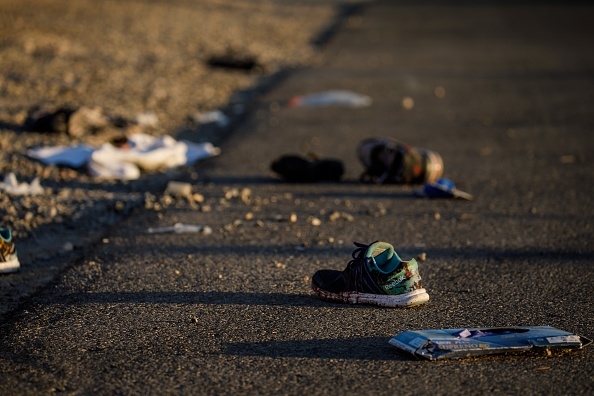You have /5 articles left.
Sign up for a free account or log in.

Discarded items in the aftermath of the Las Vegas massacre
Getty Images
In one of her essays, Joan Didion recalls living in the 1960s in “a part of Hollywood that had once been expensive and was now described by one of my acquaintances as a ‘senseless-killing neighborhood.’” In context, this is one of many little details evoking a mood of anomie (of disintegration, personal and cultural) with a hint of the Manson family somewhere upwind, performing its psychedelic-apocalyptic rituals to prepare for whatever the Beatles had commanded of them.
A bit high-strung, then, was Didion -- shifting back and forth between the heightened anxiety and the numbness that would go with residing in a “senseless-killing neighborhood,” on top of any neuroses you might bring to the place. Didion’s sentences pivot between cool understatement and a note of terror at the strain from chaos pressing in.
Fifty years on, her condition sounds almost enviable. The idea of a senseless-killing neighborhood seems like a triumph of containment. We know -- we cannot avoid the fact -- that any place can turn into a scene of random slaughter on a large scale. A study of 171 countries published last year found that the United States, with 5 percent of the world’s population, was where about 31 percent of mass shootings (defined as resulting in four or more deaths) have taken place. As of two years ago, they were occurring approximately every 12.5 days.
In most cases, shooter and victims are known to one another and the violence takes place at work or in the home. But with large-scale, random shootings, we seem to be producing killers of ambition with, in some cases, a competitive instinct. When the Virginia Tech shooting took place in April 2007, it was the most lethal in American history, with 32 casualties. That remained true for nine years, until the Pulse nightclub shooting of June 2016, with 49 murdered and 58 wounded. It took not quite 16 months for the record to be broken by Sunday night’s massacre in Las Vegas, with at least 59 dead and more than 500 wounded.
And the violence, though increasingly horrific, becomes a little less surprising with each episode -- less a matter of growing desensitized than of learned helplessness. Everyone knows in advance how the public discourse will play out: politicians and families of the deceased demand that something be done, because it’s obvious that we can’t continue like this. Statistics will show the level of public support for gun control, if only at the level of an assault-weapons ban. But anything so elementary as a national database on gun ownership will not be instituted. A few laws might be passed at the state level (for example, Nevada could outlaw private ownership of machine guns) over strenuous objections from the gun lobby, though with no certainty of enforcement in any case. Beyond that, nothing will happen until the next time something must be done -- and it won’t be then, either.
Most of us participate in these homicidal catastrophes only at a distance, through news reports. But the combined force of mass media (whether old, new or social) is to amplify awareness of each event -- to make it almost inescapable -- for a sustained period. I’ve looked through a number of recent scholarly discussions of mass shootings in the hope of finding, well, not a solution certainly, but at least some understanding of how the pressure is communicated. A couple of them bear mentioning.
In January, Frontiers of Public Health published “Media Agenda Setting Regarding Gun Violence Before and After a Mass Shooting” by Jared Michael Jashinsky, a graduate research assistant in the Department of Health Promotion and Behavior at the University of Georgia, Athens, with three co-authors.
The researchers collected 2,270 articles prominently featuring the words “firearm” or “guns” appearing in The New York Times, The Wall Street Journal and The Washington Post between September 2012 and April 2013 -- the months before and after the mass shooting at the Sandy Hook Elementary School. A statistical analysis showed a pronounced shift of emphasis in the wake of the massacre, in which 20 children and six adults were killed and the gunman killed himself.
Prior to the shooting, news reports on gun violence held individuals responsible in 63 percent of the pieces, with lawmakers framed as responsible in just 30 percent of them. After Sandy Hook, the figures were practically reversed, with lawmakers held responsible in 66 percent of the coverage and individuals in 32 percent -- with background checks as “a proposed gun violence prevention method in 18 percent of pieces before and 55 percent after Sandy Hook.” And while suicide accounts for 63 percent of deaths by gun in the United States, “a little over 10 percent of the news stories discussed suicide,” while homicides were covered in more than 90 percent of the articles. (That this adds up to more than 100 percent probably means that murder-suicides were counted in both categories.)
“While mass shootings are particularly devastating,” the paper states, “the U.S. may be inaccurately placing a majority of its media, policy and national discussions on a relatively small component of gun violence.”
Small perhaps, but also capable of disproportionate impact on already troubled minds. “Mass Shootings: The Role of the Media in Promoting Generalized Imitation” by James N. Meindl and Jonathan W. Ivy, appearing in the American Journal of Public Health in March, considers the idea of mass shootings as a source of contagious violence. (Meindl is an assistant professor of applied behavior analysis and special education at the University of Memphis; Ivy, an assistant professor of psychology at Pennsylvania State University.) They find the metaphor of gun killing as an infectious disease less plausible than the more focused concept of “generalized imitation” -- that is, a “learned ability to perform behaviors that are similar to behaviors observed or described, even when performance is delayed.” Behavior is likely to be transmissible to people when modeled by someone “who is similar to themselves, particularly in terms of age and gender; who is of an elevated social status; who is seen being rewarded; and who is seen as competent.”
The inadvertent effect of a massacre entering the 24-hour news cycle, then, is to elevate the perpetrator to prominence and draw the attention of those who might have overlooked their similarity to him.
“When the media repeatedly describes a purported motive for the shooting,” write Meindl and Ivy, “they may inadvertently be pointing out similarities between the shooter and others that may have otherwise gone unnoticed. For example, stating that a shooter took revenge after years of bullying may portray a mass shooting as one possible response option for individuals experiencing bullying and with similar backgrounds as the shooter. Understanding the motive for a mass shooting is undoubtedly important, but in-depth descriptions of rationales may serve not only to inform but also to increase the likelihood of imitation.”
An obvious implication is that unsensationalistic coverage that avoids turning a mass killer into a dark star of antiheroic menace might help reduce the violence, or at least slow down the escalation somewhat. Another equally obvious implication is that nothing of the sort is going to happen, given, as the authors put it, “the continual creation and expansion of social and new media platforms.” It is possible to avoid the news coverage of the Las Vegas massacre as much as possible yet still feel its aftershocks. It is amazing and appalling, the things that come to seem almost normal.








